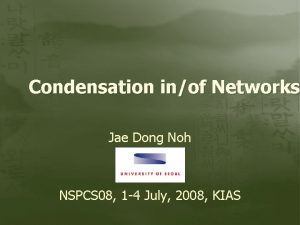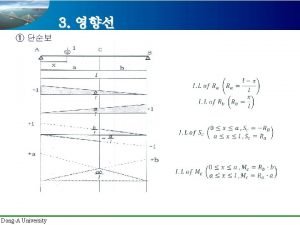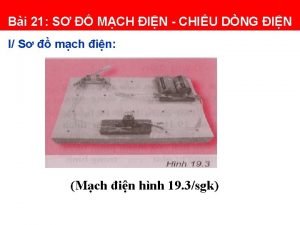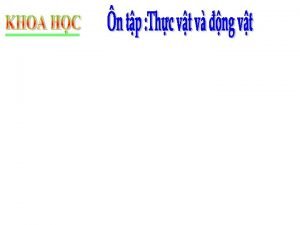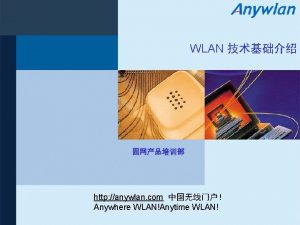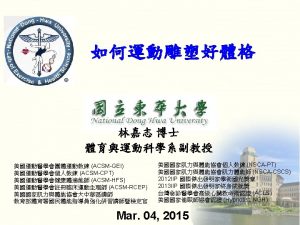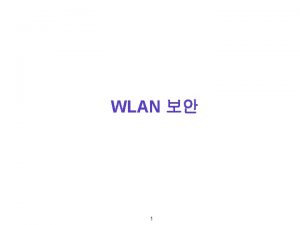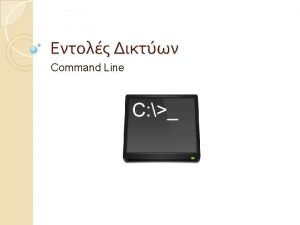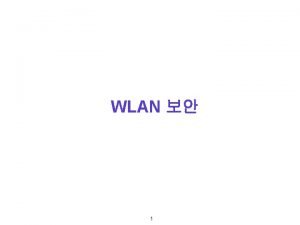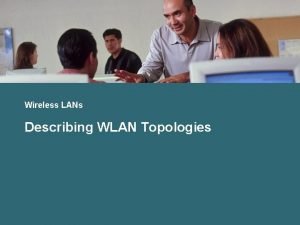Dong Wang WLAN TRENDS Agenda What is WLAN














- Slides: 14

Dong Wang WLAN TRENDS

Agenda What is WLAN? How does WLAN work? Standards related to WLAN IEEE 802. 11 a IEEE 802. 11 b IEEE 802. 11 g IEEE 802. 11 n IEEE 802. 11 VHT

What is WLAN? A wireless local area network (WLAN) is two or more computers joined together using radio frequency (RF) transmissions. Wireless LANs have a nominal data transfer rate of between 11 and 54 Megabits per second (Mbps) compared to most wired LANs in schools which operate at 100 Mbps or 1000 Mbps. There are several wireless technologies in existence, but most wireless LANs use wireless Ethernet technologies based on IEEE 802. 11 standards

How does WLAN work?

Standards relating to WLAN The Institute of Electrical and Electronics Engineers (IEEE) IEEE 802. 11 a IEEE 802. 11 b IEEE 802. 11 g IEEE 802. 11 n (To be released) IEEE 802. 11 VHT (Conceptual period)

IEEE 802. 11 a It uses 5. 8 GHZ frequency. Nominal data rate of 54 Mbps with actual rates of between 17 to 28 Mbps Its signal range is between 35 to 120 meters from an access point and data rates begin to drop at a range of 10 to 15 meters from the AP. This standard uses OFDM (Modulation Tech. ). Compared to 802. 11 b/g deploys three nonoverlapping channels, 802. 11 a is able to deploy eight non-overlapping channels in the UK.

IEEE 802. 11 b It uses 2. 4 GHZ frequency. Nominal data rate of 11 Mbps with actual rate between 4 to 7 Mbps. Its signal range is between 30 to 90 meters from an access point and data rates begin to drop at a range of 20 to 30 meters from the AP. This standard uses DSSS (Modulation Tech. ). It provides three non-overlapping channels.

IEEE 802. 11 g It uses 2. 4 GHZ frequency. Nominal data rate of 54 Mbps with actual rate between 18 to 30 Mbps. Its signal range is between 30 to 100 meters from an access point and data rates begin to drop at a range of 20 to 30 meters from the AP. This standard uses OFDM (Modulation Tech. ). It provides three non-overlapping channels. It is backwards compatible with 802. 11 b equipment.

IEEE 802. 11 n It uses 2. 4 GHZ and 5. 8 GHZ frequency. Nominal data rate of 600 Mbps with actual rate between 110 to 130 Mbps. Its signal range is between 70 to 160 meters from an access. This standard uses OFDM (Modulation Tech. ). It is added with MIMO technology. It is backwards compatible with 802. 11 b/g equipment.

IEEE 802. 11 VHT, means very high throughput VHT, means 1 Gigabit per second (actual rate) VHT, means 10 times’

IEEE 802. 11 VHT It maybe uses sub-6 GHZ or 60 GHZ. Nominal data rate of XXXX Mbps with actual rate around 1 Gigabit per second. It will be used in wireless display technologies for HDTV, fast file transfer, and campus deployments It maybe comes to the market in 2011 or 2012.

IEEE 802. 11 VHT

Thank you! Questions?

References 1. ©Becta Technical Paper Wireless Local Area Network 2006 2. Psion Teklogix Inc. WLAN TECHNOLOGY AND MARKET TRENDS 2009 3. http: //www. networkdictionary. cn/node/689 4. http: //www. extremetech. com/article 2





